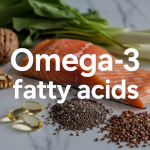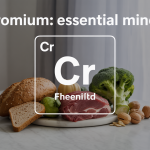Manganese might not be the most famous mineral, but your body depends on it every single day. This essential trace mineral quietly supports everything from bone formation to brain function, yet many people don’t know if they’re getting enough.
This guide is for health-conscious individuals, fitness enthusiasts, and anyone curious about optimizing their nutrition through better mineral intake. We’ll explore the critical functions manganese performs in your body and help you recognize the warning signs of deficiency that could be affecting your energy and wellbeing. You’ll also discover the best food sources to naturally meet your daily manganese requirements while learning how to maximize absorption and avoid potential toxicity issues.
Understanding Manganese and Its Role in Human Health
What manganese is and why your body needs it
Manganese is a trace mineral that your body requires in small amounts but plays outsized roles in keeping you healthy. Think of it as one of those behind-the-scenes workers that doesn’t get much attention but keeps everything running smoothly. Your body typically contains only about 12-20 milligrams of manganese at any given time, yet this tiny amount supports dozens of critical biological processes.
Your body can’t produce manganese on its own, so you must get it through food or supplements. Once absorbed, manganese spreads throughout your tissues, with the highest concentrations found in your bones, liver, kidneys, and pancreas. The mineral acts as a cofactor for several important enzymes, meaning these enzymes simply can’t function without manganese present.
The daily recommended intake varies by age and sex, but most adults need between 1.8-2.3 milligrams per day. While deficiency is relatively rare in developed countries, getting adequate amounts ensures your body can perform essential functions like wound healing, bone formation, and energy metabolism. Without sufficient manganese, these processes slow down or become less efficient, potentially leading to health issues over time.
How manganese differs from other essential minerals
Unlike iron or calcium, which your body needs in relatively large quantities, manganese falls into the trace mineral category. This means you need only tiny amounts compared to major minerals. While iron requirements range from 8-18 milligrams daily and calcium needs reach 1,000-1,200 milligrams, manganese requirements stay well under 5 milligrams per day.
Manganese also differs in how your body handles it. Your intestines are remarkably good at regulating manganese absorption based on your body’s current needs. When stores are adequate, absorption decreases. When levels drop, your body absorbs more from food. This built-in regulation system helps prevent both deficiency and toxicity under normal circumstances.
The mineral’s storage pattern sets it apart too. While iron gets stored in your liver and spleen, and calcium builds up in bones and teeth, manganese distributes more evenly throughout your body tissues. This widespread distribution reflects its role in supporting cellular processes across multiple organ systems rather than concentrating in one specific area.
The connection between manganese and optimal bodily functions
Manganese serves as a key player in several enzyme systems that keep your body functioning at its best. The mineral is essential for superoxide dismutase, an antioxidant enzyme that protects your cells from damage caused by free radicals. This protection helps maintain healthy aging and reduces cellular stress throughout your body.
Bone health depends heavily on adequate manganese levels. The mineral helps activate enzymes involved in cartilage and bone formation, working alongside calcium and vitamin D to maintain strong skeletal structure. People with higher manganese intake often show better bone density measurements, particularly in their spine and hips.
Your metabolism also relies on manganese for proper function. The mineral supports enzymes that break down carbohydrates, proteins, and fats for energy. It plays a role in cholesterol production and helps your body process amino acids effectively. Blood sugar regulation benefits from manganese too, as the mineral supports insulin production and glucose metabolism. These metabolic functions directly impact your energy levels, weight management, and overall vitality throughout the day.
Critical Functions Manganese Performs in Your Body

Supporting bone development and maintaining skeletal strength
Manganese plays a starring role in keeping your bones strong and healthy throughout your life. This mineral works as a cofactor for several enzymes that build and maintain bone tissue, including those responsible for creating the protein matrix that gives bones their structure.
Your body needs manganese to produce collagen and glycosaminoglycans – the building blocks that form the foundation of healthy bones. Without adequate manganese, your skeletal system struggles to maintain its density and strength, potentially leading to increased fracture risk and bone-related health issues as you age.
The mineral also supports the formation of cartilage, the smooth tissue that cushions your joints and allows for pain-free movement. Athletes and active individuals particularly benefit from sufficient manganese intake, as their bones and joints experience more stress and require optimal support for repair and maintenance.
Facilitating wound healing and collagen production
When you get a cut, scrape, or any type of injury, manganese springs into action to help your body heal effectively. This mineral serves as an essential component in the synthesis of collagen, the most abundant protein in your body that forms the structural foundation for skin, blood vessels, and connective tissues.
During the wound healing process, your body ramps up collagen production to repair damaged tissue and create new, healthy skin. Manganese-dependent enzymes work around the clock to ensure this collagen is properly formed and cross-linked, creating strong, flexible scar tissue that restores function to the injured area.
Beyond wound repair, adequate manganese levels help maintain healthy skin elasticity and appearance. The mineral supports the ongoing renewal of skin cells and helps prevent premature aging by ensuring your body can continue producing high-quality collagen as you get older.
Enhancing brain function and nervous system health
Your brain relies heavily on manganese for optimal performance and protection. This trace mineral concentrates in areas of high metabolic activity within the brain, where it supports neurotransmitter production and helps maintain healthy communication between nerve cells.
Manganese acts as a cofactor for enzymes involved in the synthesis of important brain chemicals, including dopamine and serotonin, which regulate mood, motivation, and overall mental well-being. Proper manganese levels contribute to better focus, memory retention, and cognitive processing speed.
The mineral also helps protect your nervous system from oxidative stress and inflammation, two factors that can contribute to neurodegenerative diseases and age-related cognitive decline. By supporting the brain’s natural defense mechanisms, manganese helps maintain sharp mental function throughout your lifetime.
Boosting antioxidant defenses against cellular damage
Manganese serves as a critical component of one of your body’s most powerful antioxidant enzymes: manganese superoxide dismutase (MnSOD). This enzyme works tirelessly in your cells’ mitochondria – the powerhouses where energy is produced – to neutralize harmful free radicals before they can cause damage.
Free radicals are unstable molecules that form naturally during metabolism but can wreak havoc on your cells if left unchecked. They contribute to aging, chronic diseases, and cellular dysfunction. MnSOD specifically targets superoxide radicals, transforming them into less harmful compounds that your body can easily eliminate.
This antioxidant protection is especially important for high-energy organs like your heart, brain, and liver, which produce more free radicals due to their intense metabolic activity. By ensuring adequate manganese intake, you’re giving your cells the tools they need to maintain their health and function optimally, potentially reducing your risk of chronic diseases and supporting healthy aging.
Recognizing Manganese Deficiency Signs and Health Consequences

Common symptoms that indicate low manganese levels
Manganese deficiency presents itself through a variety of subtle yet telling symptoms that many people overlook. The most noticeable early signs include persistent fatigue and unexplained weakness, even after adequate rest. You might experience slow wound healing, where cuts and scrapes take longer than usual to repair themselves.
Skin issues frequently emerge as another red flag. People with low manganese often develop dermatitis, characterized by dry, flaky, or irritated patches of skin. Hair and nail problems also surface – you may notice your hair becoming brittle, losing its natural luster, or even changing color slightly. Nails might become weak, brittle, or develop ridges.
Bone-related symptoms represent another category of warning signs. Joint pain, particularly in weight-bearing areas like knees and hips, can signal insufficient manganese levels. Some people experience general bone aches or develop an increased susceptibility to fractures.
Neurological symptoms shouldn’t be ignored either. Brain fog, difficulty concentrating, and memory problems can all stem from manganese deficiency. Some individuals report dizziness, coordination issues, or changes in their sense of balance. Mood changes, including increased irritability or mild depression, may also occur.
Reproductive health can suffer as well, with both men and women potentially experiencing fertility challenges when manganese levels drop too low.
Long-term health risks of inadequate manganese intake
Chronic manganese deficiency sets the stage for serious health complications that can significantly impact quality of life. Bone health takes a major hit over time, as manganese plays a crucial role in bone formation and maintenance. Without adequate levels, you face an increased risk of osteoporosis, particularly as you age. Your bones become more porous and fragile, making fractures more likely even from minor impacts.
The metabolic consequences prove equally concerning. Your body’s ability to process carbohydrates becomes impaired, potentially leading to blood sugar regulation problems. This disruption can contribute to the development of insulin resistance and increase your risk of type 2 diabetes. Fat metabolism also suffers, which can affect your overall energy levels and weight management.
Reproductive health faces long-term challenges too. Women may experience irregular menstrual cycles or fertility issues, while men might encounter reduced sperm quality or testosterone production problems. These effects can have lasting impacts on family planning and overall reproductive wellness.
Your immune system weakens gradually, making you more susceptible to infections and illnesses. This compromised immunity means you might find yourself getting sick more frequently or taking longer to recover from common ailments.
Cardiovascular health also deteriorates over time. Manganese deficiency can contribute to abnormal cholesterol levels and increased inflammation throughout the body, raising your risk of heart disease and stroke.
Who is most at risk for manganese deficiency
Several groups face higher risks of developing manganese deficiency due to various lifestyle, dietary, or health factors. Vegetarians and vegans, while generally consuming manganese-rich plant foods, sometimes struggle with absorption issues due to high fiber intake, which can bind minerals and reduce their availability.
People with digestive disorders face significant challenges. Those with celiac disease, Crohn’s disease, or inflammatory bowel syndrome often have damaged intestinal linings that can’t absorb manganese effectively. Similarly, individuals who’ve undergone gastric bypass surgery or other weight-loss procedures may have reduced absorption capacity.
Older adults represent another at-risk population. Age-related changes in digestion, medication use, and dietary patterns can all contribute to lower manganese levels. Many seniors also have reduced stomach acid production, which affects mineral absorption.
Heavy alcohol consumers face an increased risk because alcohol interferes with manganese absorption and increases its excretion through urine. Additionally, people taking certain medications – particularly antacids, calcium supplements, or iron supplements – may experience reduced manganese absorption due to mineral competition.
Individuals following highly processed diets miss out on natural manganese sources. Those who rely heavily on refined foods, fast food, or packaged meals often consume inadequate amounts of this essential mineral.
Athletes and people with high physical stress may have increased manganese needs that aren’t met through diet alone. Their bodies use more manganese for energy metabolism and antioxidant functions, potentially creating a deficiency despite normal dietary intake.
Top Food Sources to Meet Your Daily Manganese Requirements
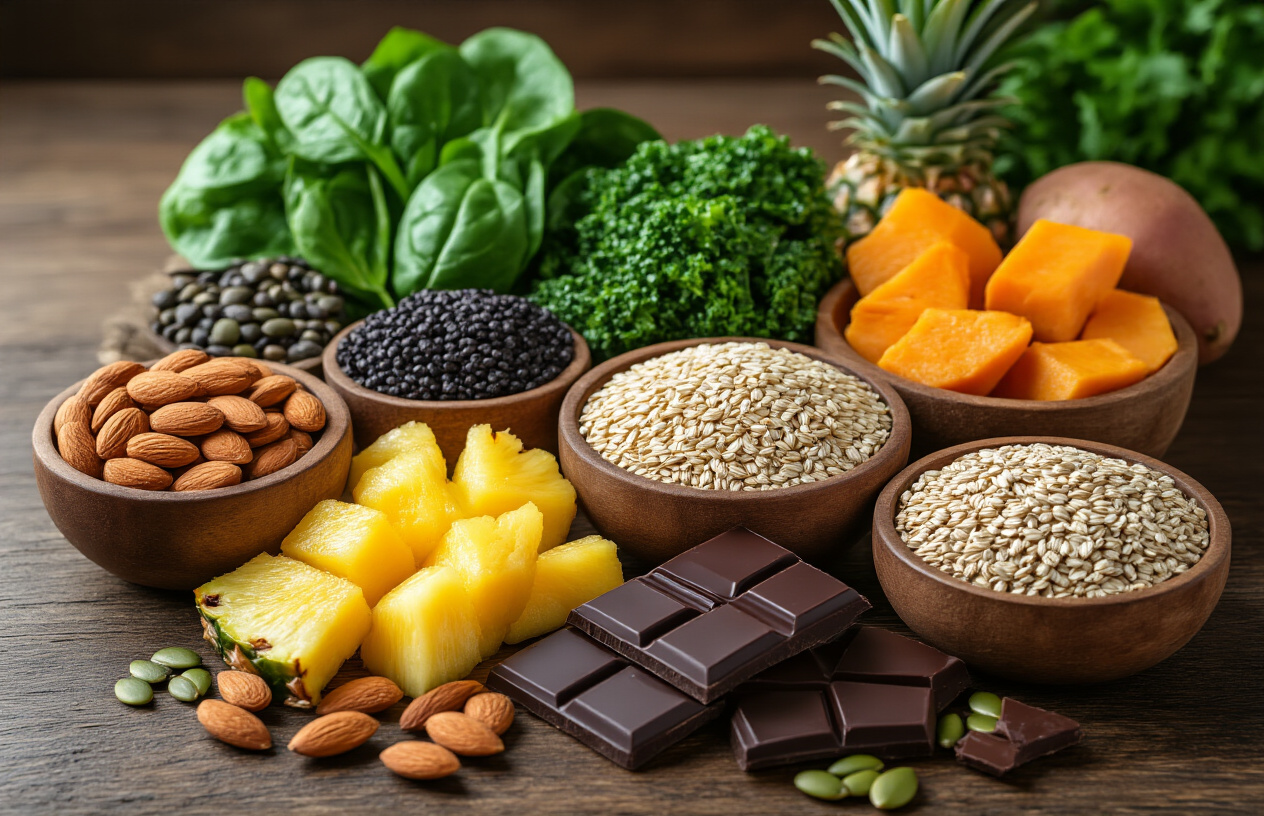
Plant-based foods rich in bioavailable manganese
Leafy green vegetables top the list when it comes to manganese powerhouses. Spinach delivers about 0.8 mg per cooked cup, while Swiss chard provides around 0.4 mg. These greens also contain compounds that help your body absorb manganese more effectively.
Legumes pack a serious manganese punch too. Lima beans contain approximately 1.9 mg per cup, making them one of the richest sources available. Chickpeas, black beans, and navy beans all provide substantial amounts, ranging from 0.5 to 1.5 mg per serving. The fiber in legumes actually works alongside manganese to support digestive health and bone formation.
Seeds deserve special attention for their concentrated manganese content. Pumpkin seeds contain about 1.3 mg per ounce, while sesame seeds provide around 0.7 mg. Sunflower seeds and flaxseeds also contribute meaningful amounts to your daily intake.
Herbs and spices shouldn’t be overlooked despite their small serving sizes. Cloves contain an impressive 5.9 mg per tablespoon, though you’d typically use much less. Ground cinnamon, black pepper, and turmeric all add both flavor and manganese to your meals.
Whole grains and nuts that boost manganese intake
Brown rice stands out among grains, delivering about 2.1 mg of manganese per cooked cup – that’s nearly your entire daily requirement in one serving. Quinoa provides around 1.2 mg per cup, while oats contain approximately 1.3 mg per cooked cup.
Wheat germ deserves recognition as a manganese superstar, containing about 13 mg per cup. Even a small sprinkle on yogurt or cereal significantly boosts your intake. Whole wheat bread provides moderate amounts, with about 0.6 mg per slice.
| Grain/Nut | Manganese Content (mg) | Serving Size |
|---|---|---|
| Brown rice | 2.1 | 1 cup cooked |
| Quinoa | 1.2 | 1 cup cooked |
| Oats | 1.3 | 1 cup cooked |
| Hazelnuts | 6.2 | 1 cup |
| Almonds | 2.3 | 1 cup |
| Pine nuts | 8.8 | 1 cup |
Nuts are manganese goldmines. Hazelnuts lead the pack with 6.2 mg per cup, followed by pine nuts at 8.8 mg per cup. Almonds, pecans, and walnuts all provide substantial amounts, typically ranging from 1-3 mg per cup. These make excellent snacks that combine healthy fats with your manganese needs.
Fruits and vegetables with significant manganese content
Pineapple stands as the fruit kingdom’s manganese champion, providing about 2.6 mg per cup of chunks. This tropical fruit makes getting your daily manganese both delicious and refreshing. Raspberries and blackberries contain moderate amounts, with about 0.8 mg per cup.
Root vegetables surprise many people with their manganese content. Sweet potatoes contain around 0.8 mg per medium baked potato, while regular potatoes provide about 0.4 mg. Beets deliver approximately 0.7 mg per cup when cooked.
Cruciferous vegetables contribute steady amounts of manganese. Broccoli provides about 0.2 mg per cup, while Brussels sprouts contain around 0.3 mg per cup. Though these amounts seem small, they add up when you eat varied vegetables throughout the day.
Green beans contain about 0.4 mg per cup, and asparagus provides roughly 0.2 mg per cup. These vegetables work well as side dishes that complement manganese-rich main courses.
How food processing affects manganese levels
Processing dramatically reduces manganese content in foods. White rice contains only about 0.7 mg per cup compared to brown rice’s 2.1 mg – processing removes nearly 70% of the mineral. White flour shows similar losses, containing roughly 80% less manganese than whole wheat flour.
Refined sugar contains virtually no manganese, while unrefined alternatives like blackstrap molasses provide about 0.9 mg per tablespoon. This shows how refining strips away beneficial minerals along with fiber and other nutrients.
Cooking methods matter too. Boiling vegetables in large amounts of water can leach manganese into the cooking liquid. Steaming, roasting, or quick sautéing preserves more of the mineral. When you do boil vegetables, save the cooking water for soups or smoothies to recapture lost nutrients.
Canned foods often retain reasonable manganese levels, especially when packed in their own juices. However, fresh or frozen options typically provide higher concentrations. Food storage doesn’t significantly impact manganese content, so properly stored whole foods maintain their mineral value over time.
Industrial food processing, like creating instant oats from whole oats, typically reduces manganese by 20-40%. Choosing minimally processed versions of your favorite foods helps maximize your manganese intake naturally.
Optimizing Manganese Absorption and Avoiding Toxicity
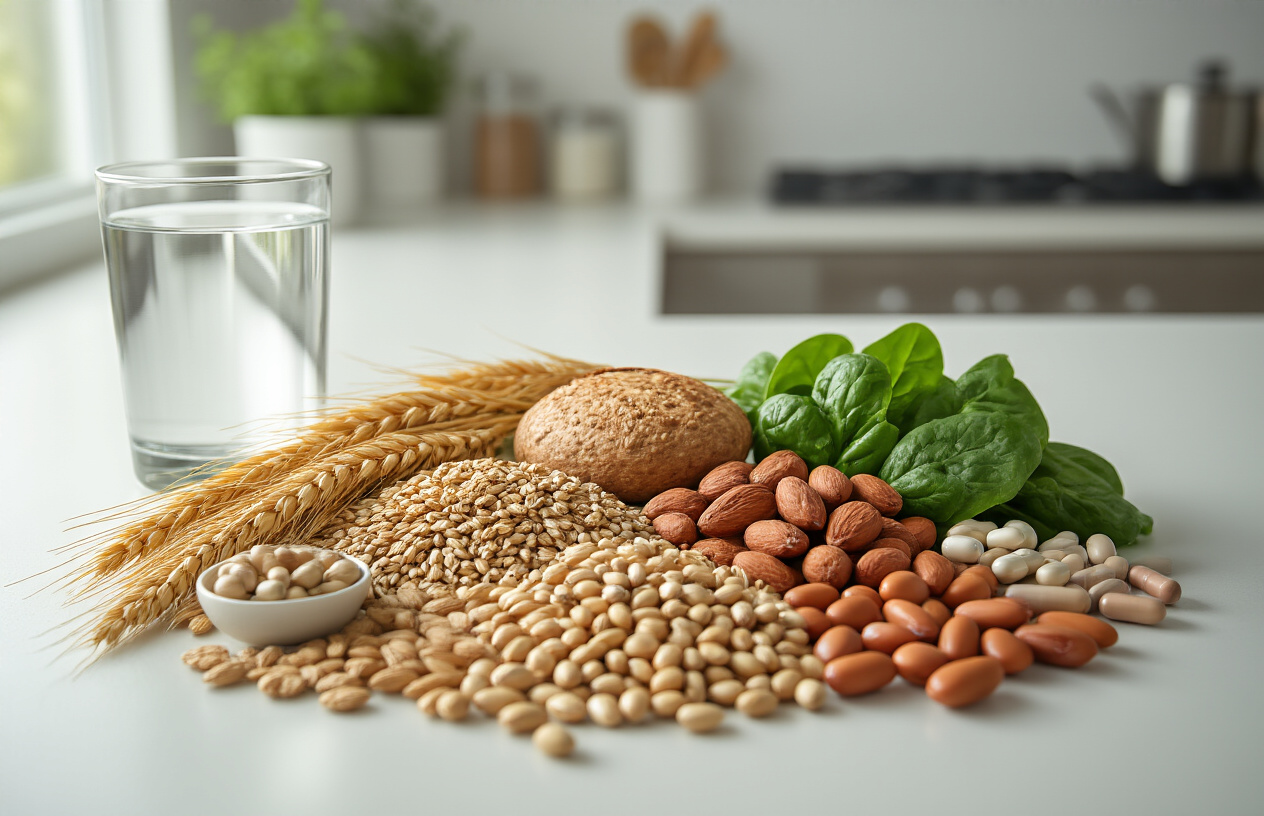
Factors that enhance manganese absorption in your body
Your body absorbs manganese most effectively when certain conditions are met. Consuming manganese-rich foods on an empty stomach can boost absorption rates since there’s less competition from other minerals. The presence of certain amino acids, particularly those found in protein-rich foods like meat and legumes, creates an environment that helps your intestinal tract take up manganese more efficiently.
Vitamin C plays a supportive role in manganese absorption, though the relationship isn’t as strong as with iron. Including citrus fruits, bell peppers, or strawberries with your manganese-rich meals can provide a modest enhancement. Your overall digestive health also matters – a healthy gut lining with proper pH levels allows for better mineral absorption across the board.
Interestingly, your body’s manganese absorption naturally increases when your stores are low, demonstrating an intelligent regulatory system. This adaptive mechanism helps prevent deficiency during periods of inadequate intake.
Substances that can interfere with manganese uptake
Several common dietary components can block or reduce manganese absorption. Iron stands out as the biggest competitor – when you consume high amounts of iron supplements or iron-rich foods simultaneously with manganese sources, your body preferentially absorbs iron, leaving less manganese available for uptake.
Calcium and magnesium also compete with manganese for the same absorption pathways. This means taking calcium supplements or consuming dairy products alongside manganese-rich foods can significantly reduce how much manganese your body actually uses.
Phytic acid, found in whole grains, nuts, and seeds, binds to manganese and makes it less available for absorption. While these foods often contain manganese themselves, the net benefit may be lower than expected. Soaking grains and nuts before eating can help reduce phytic acid content.
| Absorption Inhibitors | Common Sources | Impact Level |
|---|---|---|
| Iron | Red meat, supplements | High |
| Calcium | Dairy products, supplements | Moderate |
| Magnesium | Leafy greens, supplements | Moderate |
| Phytic acid | Whole grains, nuts, seeds | Moderate |
| Tannins | Tea, coffee, red wine | Low to moderate |
Coffee and tea contain tannins that can bind minerals, including manganese. If you’re concerned about manganese intake, consider spacing these beverages away from your main meals by at least an hour.
Safe dosage guidelines and potential risks of excess intake
The recommended dietary allowance for manganese sits at 2.3 mg daily for adult men and 1.8 mg for adult women. Pregnant and breastfeeding women need slightly more – around 2.0 mg and 2.6 mg respectively. These amounts are easily achievable through a balanced diet that includes whole grains, nuts, and vegetables.
Getting manganese from food sources rarely causes problems since your body regulates absorption based on need. However, supplements and occupational exposure present different challenges. The tolerable upper limit is set at 11 mg daily for adults, though symptoms of toxicity can appear at lower levels with chronic exposure.
Manganese toxicity primarily affects the nervous system, causing symptoms that resemble Parkinson’s disease. Early signs include:
- Muscle stiffness and tremors
- Difficulty with coordination and balance
- Mood changes and irritability
- Problems with memory and concentration
- Changes in walking patterns
Welders and miners face higher risks due to inhaling manganese dust, which bypasses the body’s natural absorption controls. For most people, the bigger concern is taking high-dose multivitamin supplements that contain manganese alongside iron – this combination can lead to gradual accumulation over time.
People with liver disease should be particularly careful since the liver plays a key role in manganese elimination. When liver function is compromised, manganese can build up more easily, increasing toxicity risk even at normal intake levels.
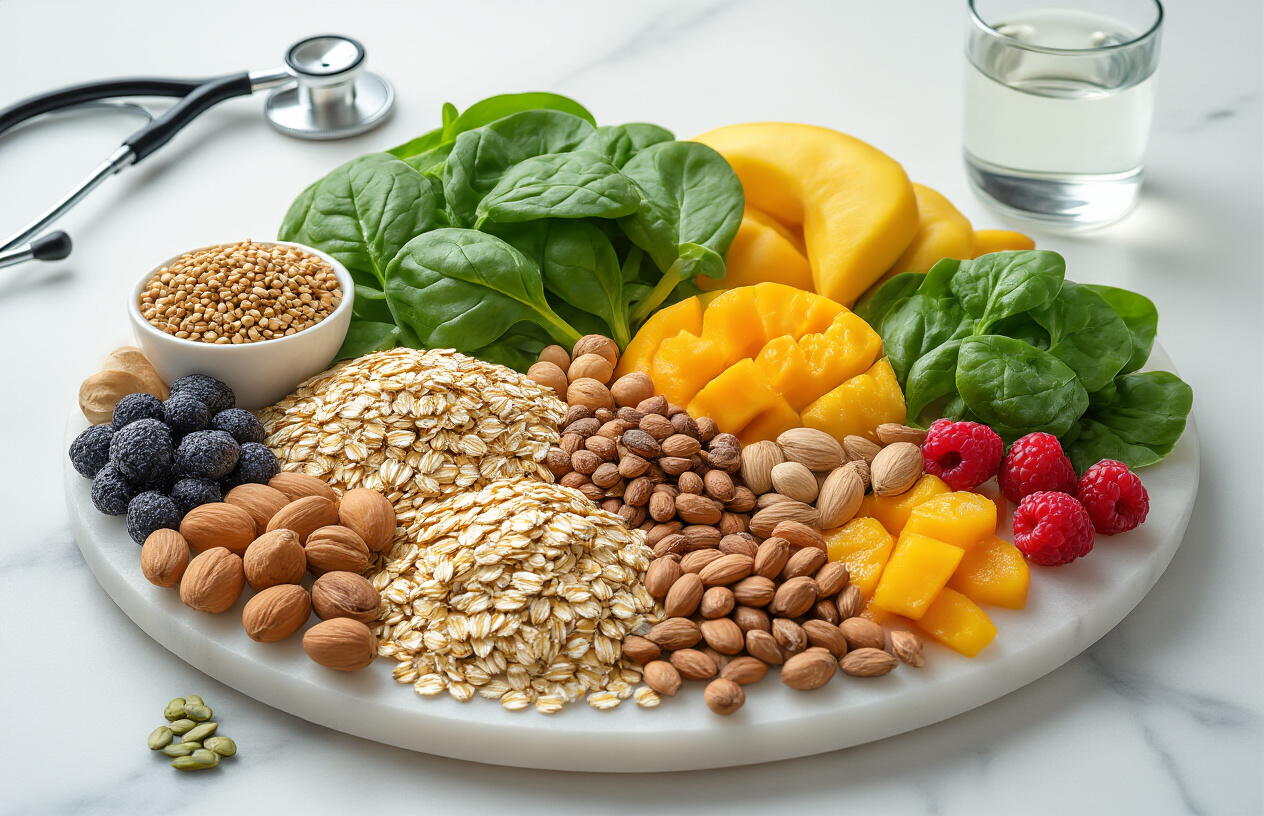
Getting enough manganese is easier than you might think, and your body will thank you for it. From supporting bone health and wound healing to keeping your metabolism running smoothly, this trace mineral punches well above its weight. The good news is that a balanced diet filled with whole grains, nuts, leafy greens, and tea can easily meet your daily needs without any guesswork.
Pay attention to what your body tells you – fatigue, weak bones, or slow healing might be signs you need to boost your manganese intake. Start simple by adding more nuts to your snacks, choosing brown rice over white, or sipping on some green tea. Remember that balance is key – while deficiency can cause problems, too much of a good thing isn’t helpful either. Focus on getting your manganese from real foods rather than supplements, and you’ll be setting yourself up for better health without any complicated routines.

